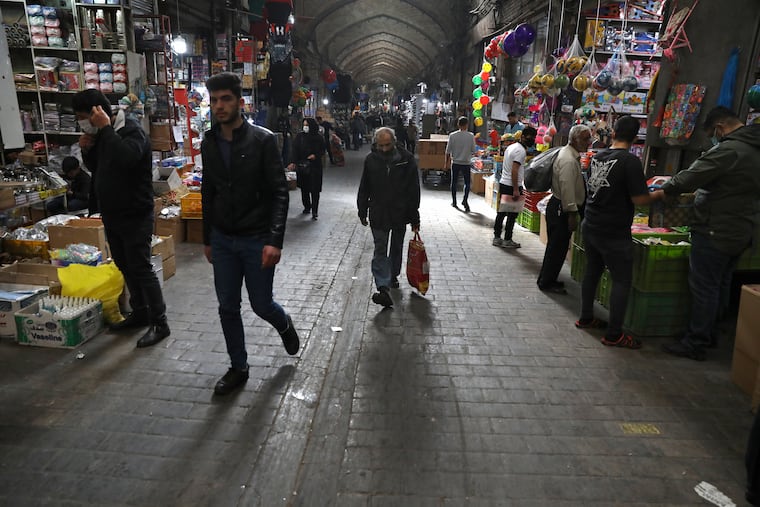The U.S. once had a friendship with Iran born in Philadelphia | Opinion
Amid another chaotic news cycle from Afghanistan risking oversimplifications of the Middle East, it’s worth reexamining U.S.-Iran relations.

The long and tumultuous history between the United States and Iran has an unexpected birthplace: Philadelphia. It was here, in the early 1720s, that the American Weekly Mercury — the first newspaper ever published in this city, and one of the first in the American colonies — introduced American readers to the concept of the “Persian Empire” (as Iran was known then). The picture it painted — of a benevolent, idyllic kingdom in the midst of a troublesome Middle East — is perhaps not what we would expect, from our current vantage point. But it was a picture that would come to shape and dominate American impressions of Iran for the next two and a half centuries. Today, as tensions persist between the two countries over Iran’s nuclear program, it is a picture worth revisiting.
To say that colonial-era Philadelphians were obsessed with Iran would be an understatement. Week after week, in the 1720s, the American Weekly Mercury competed with its archrival, the Boston News-Letter, to bring Philadelphians the latest news from the Persian Empire — sometimes devoting 20%-30% of its column inches to Iran. One issue of the Mercury, from July 1724, led with the regretful note: “We [do not] hear any thing from Persia” this week — a startling reminder that in the American colonies in the 1720s, the mere absence of news from Iran was a front-page story. In 1727, the Mercury even launched a special nine-part series, full of wild, sensationalistic coverage about noble Iranians being preyed on by savage Afghans. It was the first time an American newspaper had tried a format like this, and it was a runaway success.
“Why this early American love affair with Iran?”
Why this early American love affair with Iran? There were numerous reasons, religious as well as political. Persia occupied a special place in the Bible, as the land of Cyrus the Great, liberator of the Jews from Babylonian captivity, as well as the three Magi (the wise men from “the East” were likely Persian Zoroastrian priests).
Persia was also the archrival of the Ottoman Empire, which had possessed the Holy Land for centuries and which colonial Americans saw as the greatest threat to Christian civilization. So naturally, in 1722, when the Afghans revolted against their Persian rulers, bringing an end to the glorious empire of the Safavid dynasty, and sacking its legendary capital, Isfahan, Americans were convinced the Ottomans were secretly aiding the rebellion (they weren’t) and began cheering on the Persians. Again and again, the Mercury blasted the “wicked” Afghans and their (supposed) Ottoman backers — the first example of the American media reducing Middle Eastern actors to good guys and bad guys. Readers were told that, because the Afghans and Ottomans were both Sunni, they must have forged a crude axis of evil against poor, innocent, Shia Persia. It was complete nonsense. But the Shia were quickly portrayed as less Muslim somehow, less evil than the dominant Sunni.
Why does this history matter? Because this image of Iran — the benevolent, exotic kingdom surrounded by a sea of evil — remained surprisingly persistent in the United States, decade after decade, and never truly disappeared until the Iranian Revolution of 1979 ousted the pro-American Shah and ushered in a more fanatical Islamic Republic under Ayatollah Khomeini. As late as December 1977, just one week before the revolution broke out, President Jimmy Carter stood raising a glass at a banquet in Tehran and toasted Iran as an “island of stability in one of the more troubled areas of the world.” It was the standard way that Iran was talked about in Washington at the time. But it was also the culmination of more than 250 years of American idealization and admiration of the Persians.
» READ MORE: After Afghanistan failure, what is America prepared to fight for now? | Trudy Rubin
Nor, incidentally, did the feeling only go in one direction. The history of U.S.-Iran relations is littered with mutual admiration, mutual idealization, and mutual fascination — at least until the end of the 1970s. And on the U.S. side, this feeling was born here in Philadelphia. But it has completely disappeared since.
No one today would be naive enough to suggest that all this can easily be reclaimed or revived. Tehran and Washington, after all, have accumulated more than 40 years of mutual hatred since they broke off relations in 1980. But the spirit of early Philadelphia may still have something to teach us about the long, complicated — and sometimes surprisingly positive — history of U.S.-Iran relations.
In the midst of another chaotic news cycle from Afghanistan risking many oversimplifications of the Middle East, perhaps it is worth pausing to remember that no hatred — and no tightly held belief about one’s friends and enemies — lasts forever.
John Ghazvinian is executive director of the Middle East Center at the University of Pennsylvania and author of “America and Iran: A History, 1720 to the Present.”